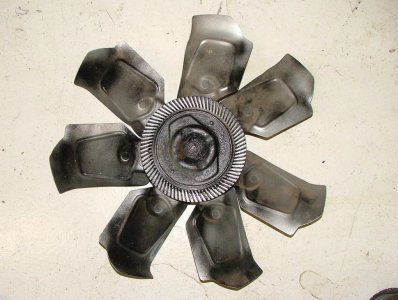Mike67
Well-Known Member
Are the gauges taking temp at different locations? That might be the decrepancy...I wonder what was the temp range on a factory gauge ; H= ?,?...
One is the factory sender right below where the heater hoses go into the block. The other taps into the plug next to where the heater hoses go into the block. Both are electrical senders. They are just inches apart.Are the gauges taking temp at different locations? That might be the decrepancy...I wonder what was the temp range on a factory gauge ; H= ?,?...
I assume the two tics on the factory gauge are minimum and maximum operating temp. If they mean if between these two tics, don't worry, it would be nice to know what the tics represent. Mine seem to be about 160 to 220.Mike, good thought. My 68 rally gauge has 170 to 230 marked on it with a top of 250deg., so maybe a L to H gauge would mean 250 as H? Sounds logical, I guess.
It is the plastic one. I have the Hayden 2947 fan clutch on order and will see if that makes any difference.'67- you said factory shroud; is it the plastic one that covers the whole radiator, not just the metal one that covers upper half? Also, maybe your old fan drive is not locking up all the way to drive fan when the higher temp is telling it to.
I don't know if 15 degrees is an accurate figure or not, but lets remember, he's passing 90-95 degree air through the condenser to remove heat from the refrigerant. Now that hot air has to pass through the radiator and is expected to remove even more heat from the radiator, on a car that was not sold as an A/C car.I recommend Classic Auto Air to everyone, but cannot agree with the 15 degree statement. Be sure to use a Stant Super-Stat 180. No chrome housing.
Car was a factory air car. I just had Classic Air rebuild the under dash unit and bought a new under hood kit from them. Should be pretty much as factory with the exception of the Sandin compressor.I don't know if 15 degrees is an accurate figure or not, but lets remember, he's passing 90-95 degree air through the condenser to remove heat from the refrigerant. Now that hot air has to pass through the radiator and is expected to remove even more heat from the radiator, on a car that was not sold as an A/C car.
Your best bet is to start with the thermostat and report back with the results.
Radiator is factory just recored, fan is factory, shroud is factory,
I am not sure if I am chasing a non problem or if this car ever ran any cooler when it rolled out of the factory in 1967. I have no idea what the normal operating range on the factory gauge has as a low and high. My factory gauge never gets to the top of normal operating range with the secondary temp gauge at 220.

7 blade 17 inch.Interesting, I have the same result with the two gauges as you. In my thread someone said it may be a non-problem. With new cars today we get used to them never overheating with the A/C on but back in the day they all got real hot if you were stuck in traffic for awhile and you would see the luxury cars with A/C pulled over with their hoods up...
What are the dimensions of your factory fan? I'm thinking of using this 20" high pitch unit:
View attachment 355947
Maybe. I don't know internally. A temoerature probe pushed through the radiator from the back side still shows over 200 degrees after shutoff.Just wondering if maybe your two senders are separated by a wall? One on inlet,other on outlet in the pump housing itself.Never looked at one that closely.
Not sure what the rubber piece is in the picture of your hood. I don't have that on my car. What is its function? To keep the fan from pulling air through the grill but over the top of the radiator? Was there one originally on a 67 GTX?
